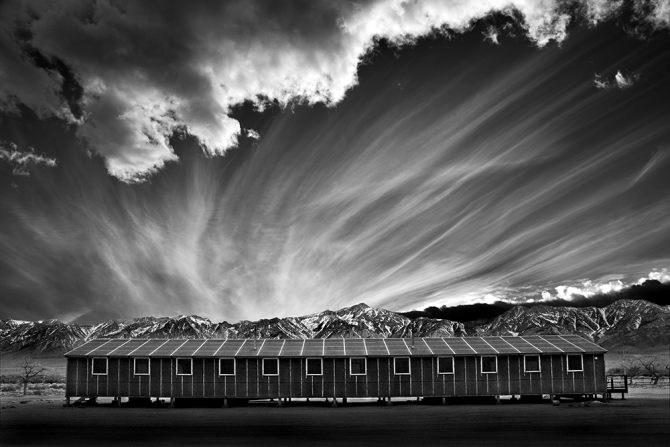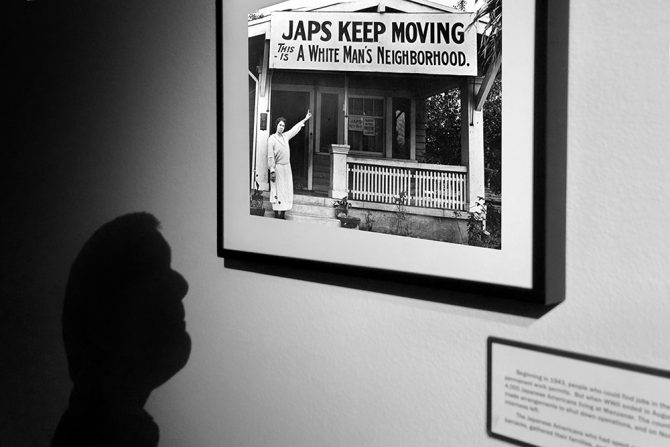January 30, 2014
Manzanar

Today I visited the Manzanar “war relocation center” near Lone Pine, California. It was one of ten camps where the US Government held 110,000 people of Japanese ancestry during World War II. Two thirds of these people were American citizens, many born in this country and yet they were deprived of their liberty and property without due process.
I felt very sad visiting here, similar to how I felt at Auschwitz. No, Manzanar did not have gas chambers or the brutality of Auschwitz, but in both places people lost their liberty and dignity.
I knew Japanese Americans who had been interned but knew little of their story until I purchased a copy of “Manzanar” by Ansel Adams. He photographed the camp in 1943 while it was still occupied. He said of his work:
“The purpose of my work was to show how these people, suffering under a great injustice, and loss of property, businesses and professions, had overcome the sense of defeat and despair by building for themselves a vital community in an arid (but magnificent) environment.”
I have great respect for Ansel’s Manzanar images and his views on the internment because it was not popular to defend the “Japs” at that time.

Fortunately he was not alone in speaking up, there were others such as newspaper editor Walter Woodward and librarian Clara Breed, also the Quakers were vocal critics of the internment policy.
Surprisingly however, there were very few politicians who stood up to decry this situation, but one who did was Governor Carr of Colorado who said:
“If you harm them, you must harm me.”
Unfortunately his continued support for the Japanese ended his promising political career. But what a wonderful legacy: here was a man who would not trade his honor for popularity or office.
Visiting Manzanar reinforced my commitment to not allow such tragedies to happen again. In the face of injustice and overwhelming popular opinion for the same, I hope I can be as principled and vocal as Ansel Adams and Governor Carr.
Cole
P.S. I created two images at Manzanar today, two are above, one below.


The vitality of these communities was indeed remarkable. One of my favorite artists is Chiura Obata, whose paintings made at the Topaz War Relocation Center in Utah are just stunning, especially given the circumstances under which they were produced.
I am ashamed to say that Japanese Canadians were also ‘interned’ as it was euphemistically referred to … it is important work that you are doing.
Regards and best wishes,
Michael
Thanks Michael, I did not know that about the Canadian Japanese.
Something I didn’t mention in my blog article was that not a single Japanese American was ever convicted of espionage, sabotage or any other war crime.
I’m always hesitate to judge those in the past by today’s standards. But I am grateful to those “progressives” who early on fight against this type of injustice.
HI Cole,
Adams images have been roundly criticized as mostly through rose colored glasses. Smiling man holding two cabbages, children smiling as they do calisthenics, etc. On the other hand, Dorothea Lange’s powerful photographs show the true pain and degradation. Check out: Impounded: Dorothea Lange and the Censored Images of Japanese American Internment if you wish to see it like it really was.
Jan
Nice that at least one politician stood up against it. Terrible thing to have happened here in America,or anywhere else,for that matter. Look forward to seeing more photos.
“The Jerome War Relocation Center was a Japanese American internment camp located in southeastern Arkansas near the town of Jerome. Open from October 1942 until June 1944,[1] it was the last relocation camp to open and the first to close; at one point it contained as many as 8,497 inhabitants.[1] After closing, it was converted into a holding camp for German prisoners of war.[1] Today, there are few remains of the camp still visible” from Wikipedia..
Another shallow subject for debate. Man, where does one begin? I knew of this, of course, as anyone who is remotely historically aware would.
What is it about humans segregating other humans for whatever imagined reason? Concentration camps (again, I say that your “Ghosts of Auswitz” is one of the most important bodies of work in the last 50 yrs), Manzanar, Indian “reservations,” ghettos. What is it in the human psyche that even allows us to think in this fashion? It must be hard wired deep in our genome.
It’s always disturbing to know, in the case of Manzanar, that just because Japanese Americans (citizens) look like the people that attacked us, that they would suddenly get orders from the “homeland” and attack us from within. I wonder if Japanese Americans who were fighting were taken off of the lines to be interred.
This is just another of the unimaginable inconceivable atrocities that occurred in WWII
I’ve heard that Japanese American soldiers who fought in WWII did so heroically, even while their families were treated so horribly. My wife is from Japan and I often think about what would have happened to her if we lived back then, or even how she would be treated if we engaged in a conflict with any Asian country in the future. Paranoia is an ugly thing.
More Americans should study history to learn what their government is capable of.
@ Mark, you may want to expand that to ALL governments. Don’t forget about Nanking, Stalin, N. Korea, Nazism, etc. It’s a human condition, not just American.
Hi all, I wanted to respond to everyone but have such limited internet here in Death Valley that I must just make a single comment.
I think Tony is right about such behavior being a human condition, and made worse when “group think” turns nastily into “mob mentality.”
I’d also like to comment on Jan’s point that Ansel’s work has been criticized for portraying Manzanar through rose colored glasses. Lange and Adams had a long standing disagreement about the role of photography. Lange argued that photography should address the human condition and be used to highlight social injustice. Adams argued that an equally legitimate purpose was to show beauty. Lange was relentless in her criticism of Adams’ approach and they fought a great deal.
http://wayneyang.wordpress.com/2005/08/22/beauty-purpose-adams-versus-lange/
So is Ansel’s portrayal of Manzanar a false one? Are Langes images more accurate? I’ll leave that to those who lived at Manzanar to judge, but I do believe that both portrayals can be accurate and tell “a” truth.
As I stated before, I am always reluctant to judge another by today’s standards or by my standards for that matter.
Cole
I forgot to respond to Jim’s comment.
The scene that touches me the most about Manzanar was the Japanese American GI’s returning on leave to visit their families…who are interned behind barbed wire fences.
That scene tugs at my heart.
Compelling comments by all.
Thanks for bringing this ugly American chapter to awareness by those who were not aware. Well done, Cole.
I recently came across some photos and documents related to one of my wife’s relative’s imprisonment at Manzanar and Tule lake and her subsequent deportation to Japan, along with about ~5000 other internees. I posted that information on my blog.I’d love to find a museum that could house these documents and photos!
There are two blog posts:
http://davidwolanski.com/2014/01/13/two-photos-that-rocked-my-world-last-year/
http://davidwolanski.com/2014/01/13/the-rest-of-the-story/
That is very cool Dave, that you found the photographs. Have you contacted the museum there at Manzanar, it is an excellent museum and has a great display of memorabilia and photographs.
Was she deported for refusing to sign the pledge?
I have two friends who were interned: one was at Manzanar and the other’s family was at Heart Mountain Relocation Center in Wyoming.
Cole
It’s not clear how she ended up in Tule Lake. It’s possible she went because one of her parents was forced to go by the authorities. I understand there was a coordinated government program to get the detainees to give up their US citizen status and be sent to Japan. Given she left so soon after the war to go to Japan, I believe she was part of that group.
I saw some info about the Manzanar museum and it didn’t look like they had many resources and weren’t open to the public very much. I’ll have to check again.
Much of the misunderstanding one might have between these two great photographers regarding Manzanar emanates from not realizing when each photographer took their pictures, and under what circumstances.
Lange was hired by an agency of the US Government to record pictures from the time of the roundup of Japanese to their dumping grounds of Manzanar. She needed a job, and her employer dictated and censored what, where, who and when she could photograph. Her husband did not publicly support her private views on this matter, and neither did her employer.
Read Impounded, as one reader suggested. Do you think Lange would be capable of taking pictures of barbed wire, machine gun towers, and nice housing for the guards/administrators (as compared to the internees? Absolutely. But she couldn’t snap away, accompanied by guards. If you read Impounded or view her images in the National Archives, Notice how pathetically bland Lange’s captions, written by herself, seem? Again the garroting of her employer.
Why didn’t her images get viewed in the 1940’s or 1950’s? Think the last scene of Indiana Jones Raiders of the Lost Arc, when Indie is promised the Government would keep the Arc safe and away, as the crate is hauled into one of man a cavernous warehouse, never to be seen. That’s what happened to Lange and her images.
Adams photographed Manzanar in 1943, about a year before it started to close down, due to a Supreme Court decision. He did this pretty much on his own. He could freely select most photos. But again, guards determined no barbed wire, gun-toting towers or other “embarrassing” pictures. Adams was greeted by internees who had resigned themselves (after 2+ years) to make the best of a bad situation, and he wanted to show that, even though he vehemently was against moving American citizens to concentration camps, with no due process of law.
For a better understanding of photographers at Manzanar in this period, read Elusive Truth, Four Photographers at Manzanar (2002) by Gerald Robinson. This book compares the 4 main photographers of Manzanar: Dorothea Lange, Clem Albers, Ansel Adam and Toyo Miyatake. Miyatake took pictures from the inside as an internee. First surreptitiously, then gradually on a leash, and finally at the end with no censoring. He’s the only one who included barbed wire in one of his last images.
Questions to Cole Thompson of your Manzanar Images
You image of the obelisk I RE I TO (“Soul Consoling Tower”) is wonderful. Again proving that one can make an image that is so different and moving from the iconic ones before (like Ansel Adams). Thank you for sharing.
The first image you show on your website titled Manzanar, Barracks – California – 2014 was equally moving. However, I was under the impression, never having been to Manzanar, that there were no barracks or buildings left. (Google Earth confirms the barrenness of the site.) Yet, in the background seems to be Mt. Williamson, which is also in the picture of the obelisk. That first picture does not have any barracks in the background. So is this 1) new barracks that have been recently built (or just PS’d in), in back of you when photographing the obelisk (that is, to the east of the obelisk or 2) Somehow a different view of Mt. Williamson?
Would like to know in preparation for a visit there.